
This is a full Canvas course shell for teaching BIO 205 Microbiology.
- Subject:
- Biology
- Material Type:
- Full Course
- Lecture
- Author:
- Eric Osborn
- Date Added:
- 03/09/2023

This is a full Canvas course shell for teaching BIO 205 Microbiology.
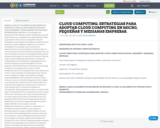
DEBIDO A QUE ACTUALMENTE SE ENCUENTRA EN REVISIÓN LA TESIS, EL DOCUMENTO ES PRIVADO POR EL MOMENTO,
PRÓXIMAMENTE SE DARÁ MAS INFORMACIÓN. GRACIAS.
La Tecnología de la Información (TI) siempre ha sido considerada un punto importante en las organizaciones empresariales, desde la perspectiva de los costos y de gestión. Es parte integral de la tecnología y los modelos de negocio de las empresas y las ha obligado a adaptarse a las nuevas estrategias de tecnología. Con los avances de infraestructura en la tecnología de la información y la comunicación, los nuevos modos de programación y los nuevos modelos en su uso; han llegado también nuevas formas de denominar los servicios de Internet. Factores como la mercantilización de hardware, software de código abierto, la virtualización, la globalización de la fuerza de trabajo y los procesos ágiles de TI han apoyado el desarrollo de nuevos modelos de tecnología y negocios. La computación en nube o Cloud Computing ofrece a las organizaciones más opciones en cuanto a cómo gestionar las infraestructuras, ahorrar costes, trabajar en equipo remotamente y delegar responsabilidades a proveedores de servicios Cloud o terceros, sin que los usuarios tengan que tener ningún conocimiento de la infraestructura que hay detrás.
La mayoría de las empresas se esfuerzan por reducir su coste del área de TI a través de los medios de virtualización. Esta demanda de reducir el costo ha dado lugar a la innovación de la computación en nube, ya que ofrece una reducción en los costos de administración así como reducción de costos de infraestructura. Los grandes beneficios del Cloud Computing permiten la adquisición de recursos computacionales de manera rápida, flexible y con un menor costo de implementación para los usuarios o empresas y es rentable para los proveedores, pues a pesar de presentar algunos riesgos, el poder trabajar con este nuevo tipo de tecnología permite al usuario ahorrarse tanto licencias, como la administración de servicios y de los equipos necesarios. Además de beneficios en términos de costo, el Cloud Computing puede presentar beneficios de seguridad ya que brinda a las empresas normas y estándares de seguridad de los más altos niveles internacionales. Incluso presenta beneficios ambientales y sociales. Todo gracias a la arquitectura conformada por los modelos con los cuales trabaja el Cloud Computing, denominadas por sus siglas: SaaS, PaaS e IaaS, las cuales corresponden al software, plataforma e infraestructura como servicios respectivamente.
El Cloud Computing se encuentra todavía en una etapa infantil y es una nueva tecnología para las micro, pequeñas, medianas o nuevas empresas. Existen pocas guías y marcos para una óptima adopción, la mayoría de ellos no se encuentran en la lengua española o no engloban todos los factores y cuestiones necesarias para generar confianza en esta tecnología. Por lo tanto, la mayoría de las empresas no están muy seguras en adoptar la tecnología. La presente tesis aborda el problema de confianza en la adopción y se discuten y analizan las barreras que se pueden presentar al adoptar la computación en nube en una empresa. Se presentan una serie de estrategias, una hoja de ruta y un marco que servirán como una guía para enfrentar los desafíos, cuestiones o factores en términos de costo, seguridad, confidencialidad, confianza, cumplimiento normativo, cumplimiento legal y cumplimento-TI, así como los factores organizacionales/humanos. En esta tesis se detallan exhaustivamente todos los temas referentes al Cloud Computing desde sus antecedentes, evolución, arquitectura, tecnología, modelos de negocio, modelos de servicio, modelos de despliegue, proveedores del servicio, etc. y así se logre un profundo entendimiento del paradigma de computación en nube. La metodología fue realizada siguiendo los lineamientos de diferentes estándares, normas, protocolos, estándares, certificados y mejores prácticas internacionalmente reconocidas respecto a la seguridad de la información en un entorno de TI ó enfocadas a entornos de Cloud Computing como: ISO/IEC 27001, ISO/IEC 27002, COBIT, ITIL, KMIP, TLS/SSL y CCSK. Esto logra una metodología con procedimientos adecuados para la adopción de Cloud Computing en las micro, pequeñas y medianas empresas que ya adoptan servicios de nube o están interesados en su adopción.
Palabras clave: Computación en Nube, Cloud Computing, SaaS, IaaS, PaaS, Costo, Cumplimiento, Seguridad, Confidencialidad, Confianza, Micro, Pequeñas y Medianas Empresas, Adopción, Estrategias.
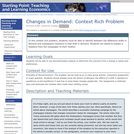
Context Rich Problem on demand shifters and the implications of such a shift.

In this context rich problem, students are asked to analyze the effects of a price ceiling.
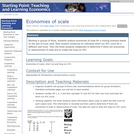
Working in groups of three, students analyze economies of scale. Each student constructs an individual short-run ATC curve, then the three students collaborate to determine if there are economies or diseconomies of scale and to create the long run ATC.

Context Rich Problem using the concepts of excise tax incidence, elasticity of demand, and elasticity of supply. Students must determine which information is appropriate and which is extraneous to the problem.
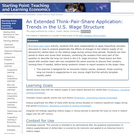
This activity uses a think-pair-share approach to helping students connect observations about disparate changes in the market for skilled/unskilled labor to long-run trends in wage inequality.
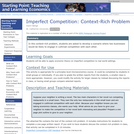
This context-rich problem helps students to apply the characteristics of imperfect competition to a real world setting.
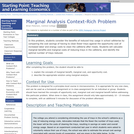
In this problem, students consider the benefits of reduced tray usage in school cafeterias by comparing the cost savings of having to clean fewer trays against the opportunity cost of increased labor and energy costs to clean the cafeteria after meals.

Lecture Objective: Students understand what “there ain't no such thing as a free lunch” really means. In other words, they can identify different types of nonmonetary compensation and how they form part of real wages.
The lesson incorporates two MRU videos about compensating wage differentials from our Principles of Microeconomics video course. We also mix in discussion prompts, exercises, practice questions, graphs and charts, and pre- and post-class assignments. Finally, we provide supplementary resources such as additional data sources, relevant news articles and blog posts, two episodes of Planet Money, and a podcast conversation between Tyler Cowen and Peter Thiel.
------------------------------------
What is Marginal Revolution University (MRU)?
Many of us can remember our first great economics teacher who fundamentally changed how we see the world. At MRU, we try and deliver that experience to millions worldwide through video.
Founded as a nonprofit in 2012 by George Mason University economics professors Tyler Cowen and Alex Tabarrok, MRU is building the world’s largest online library of free economics education videos -- currently weighing in at more than 800 videos.
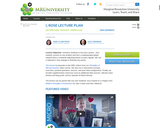
Lecture Objective: Introduce students to the price system - how markets connect to one another and form a sophisticated global network that is constantly adjusting based on price signals. We use a Valentine’s Day analogy to illustrate key points.
The lesson incorporates a few MRU videos from MRU's Principles of Microeconomics video course. We also mix in discussion prompts, exercises, practice questions, and pre- and post-class assignments. Finally, we provide supplementary resources such as additional data sources, relevant news articles and blog posts, and an episode of Planet Money.
------------------------------------
What is Marginal Revolution University (MRU)?
Many of us can remember our first great economics teacher who fundamentally changed how we see the world. At MRU, we try and deliver that experience to millions worldwide through video.
Founded as a nonprofit in 2012 by George Mason University economics professors Tyler Cowen and Alex Tabarrok, MRU is building the world’s largest online library of free economics education videos -- currently weighing in at more than 800 videos.

Multi-scale systems (MuSS) consist of components from two or more length scales (nano, micro, meso, or macro-scales). In MuSS, the engineering modeling, design principles, and fabrication processes of the components are fundamentally different. The challenge is to make these components so they are conceptually and model-wise compatible with other-scale components with which they interface. This course covers the fundamental properties of scales, design theories, modeling methods and manufacturing issues which must be addressed in these systems. Examples of MuSS include precision instruments, nanomanipulators, fiber optics, micro/nano-photonics, nanorobotics, MEMS (piezoelectric driven manipulators and optics), X-Ray telescopes and carbon nano-tube assemblies. Students master the materials through problem sets and a project literature critique.
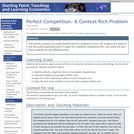
Students find the profit-maximizing level of output for a perfectly competitive firm and check the shut-down condition for two different prices.
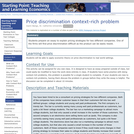
Students prepare an essay to explain pricing strategies for two different companies.
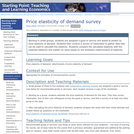
Students survey class members to estimate the price elasticity of demand for a number of goods and services.
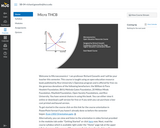
This is a full course in the principles of microeconomics.
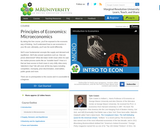
With this free video resource, students will be exposed to the economic way of thinking. Students will understand how to use economics in their lives and, ultimately, you’ll see the world differently-- all through engaging Hollywood production style videos.
Educators can use MRU's videos in a variety of ways, to include “flipping” the classroom, as study aids, supplementary material, concept reinforcement, or even as a full course offering.
In MRU's Principles of Microeconomics course, covers fundamental concepts like supply and demand and equilibrium. We also answer questions such as: How are prices determined? What did Adam Smith mean when he said the market process works like an “invisible hand”? How is it that we have access to fresh roses in very cold cities every Valentine’s Day? All key topics are covered to include competition, monopoly, price discrimination, externalities, public goods and more.
There are no prerequisites for this course, and it is accessible to beginners.
------------------------------------
What is Marginal Revolution University (MRU)?
Many of us can remember our first great economics teacher who fundamentally changed how we see the world. At MRU, we try and deliver that experience to millions worldwide through video.
Founded as a nonprofit in 2012 by George Mason University economics professors Tyler Cowen and Alex Tabarrok, MRU is building the world’s largest online library of free economics education videos -- currently weighing in at more than 800 videos.
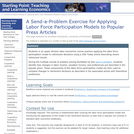
Send-a-problem exercise used to link economic theory covered in a labor economics course with related trends exemplified in a popular press article.
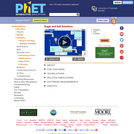
What happens when sugar and salt are added to water? Pour in sugar, shake in salt, and evaporate water to see the effects on concentration and conductivity. Zoom in to see how different sugar and salt compounds dissolve. Zoom in again to explore the role of water.
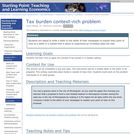
Students are asked to write a letter to the editor of their newspaper to explain their point of view as a seller in a market that is about to experience an increased sales tax rate.